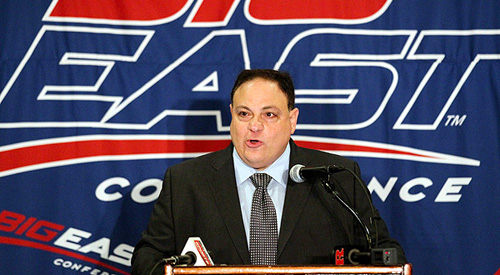
John Marinatto’s departure, Idaho’s pending FCS move signs of NCAA’s future
At first, there doesn’t seem to be many massive implications from commissioner John Marinatto’s exit from the Big East or Idaho’s potential move down to the FCS level. Marinatto was a commissioner in charge of a conference that’s rapidly lost its lustre in the last few years, recently suffering the departures of West Virginia, Pitt and Syracuse (plus TCU, who never actually played in the conference) and was forced to expand nationally in an attempt to keep some relevance.
The Big East may not even find itself heavily involved in whatever playoff formula eventually emerges.
Meanwhile, Idaho was never all that impressive at the top level of college football; the Vandals only moved up to what’s now the FBS in 1996, and they’ve only recorded 39 wins (against 104 losses) since 2000. However, while both moves may seem relatively insignificant in and of themselves, they’re more interesting as indicators of how the NCAA is changing.
In many ways, Marinatto was emblematic of the older trend of college athletics. He graduated from (Big East member) Providence College in 1979 with a business degree, then worked at the school as associate director of alumni and development, as director of sports information and eventually as the athletic director for 14 years. Following that, he took over as Big East commissioner in 2002, only to see prominent schools Miami, Boston College and Virginia Tech leave for the ACC in 2003.
[php snippet=1]
Marinatto replaced them with a raid on Conference USA, but tensions mounted again in this latest round of realignment, and he didn’t have enough goodwill left to survive the most recent prominent defections. Yahoo! Sports’ Pat Forde’s take on Marinatto’s exit is notable, particularly for the way he describes Marinatto’s athletic-department lifer background (at one time, the standard for conference commissioners) in contrast to those who are leading prominent conferences at the moment:
In 2002, the SEC brought in an Ivy League-educated northeastern lawyer in Mike Slive and has enjoyed a golden era of achievement and enrichment. In 1989, the Big Ten took a chance on former Ohio Valley Conference commissioner Jim Delany – a guy from back east who played basketball on Tobacco Road, then busted bad guys for the NCAA – and hit a home run. The Pac-12 has gotten great early run from [Larry Scott], a complete outsider who worked previously in professional tennis.
The astonishing amount of money being made in big-time college athletics flows through the conference office. So do all the high-profile decisions, from affiliation to postseason football.
Commissioners must have a firm grasp on those crucial decisions. Or at least look like they do.
At the annual BCS meetings in Florida last month, the guys doing almost all the talking were Slive, Delany and Scott. I’m not sure anyone even saw Marinatto, much less talked to him. He lived down to his reputation as the invisible, low-impact face of the Big East.
John Marinatto is a good man who has worked hard for a conference he cares about deeply. But in today’s college sports landscape, that’s not enough to keep a high-profile, high-pressure commissioner’s job.
The Idaho situation seems quite different at first glance, but there are plenty of similarities. Just as the Big East’s once-solid situation became untenable as the football dollars grew (and their prominent schools started looking for bigger television revenues), Idaho was once entrenched in the Western Athletic Conference, and the Vandals even showed promise at times. However, the WAC is disintegrating at the moment, partly in response to the Big East’s own moves (they raided the Mountain West for Boise State and San Diego State and Conference USA for UCF, SMU, and Houston, which in turn caused the MWC and C-USA to conduct their own raids on the WAC), and it’s looking like the only landing place for the Vandals may be the FCS. University president Duane Nellis wrote on his Facebook page that he thinks this is because of larger factors in conference realignment:
It is clear from my many conversations with presidents and conference commissioners from across the country including many representing conferences in the west—the key variable for adding new teams is immediate media market. The fact that we are currently atop the WAC Commissioners Cup, have great success in student athlete graduation, are a top quality academic institution, and have invested and continue to invest in athletic facilities at our university seems to mean nothing. As you well know TV networks like ESPN are now running major college athletic affiliations not the NCAA. Please stand by us as we work to make this frustrating situation a positive one for the University of Idaho, its Vandal alumni, family and friends.
Nellis’ comments obviously come from a place of frustration, and they’re through Idaho-coloured glasses (a neutral party might have also considered the Vandals’ lack of prolonged gridiron success to be a factor), but he makes some valid points. Similarly, while Marinatto’s tenure at the helm of the Big East may have been less than overwhelmingly successful, some of that was thanks to factors outside his control, including the way college football’s transforming at the moment. This is a big business, and it’s becoming a bigger one all the time. While that can lead to great rewards for those who thrive in the new environment, like Scott and certain powerhouse teams, it’s going to leave plenty of casualties along the way. John Marinatto’s tenure as Big East commissioner and the Idaho football program’s time at the FBS level are just two obvious ones at the moment; who knows what dominoes will fall next?
[php snippet=1]

